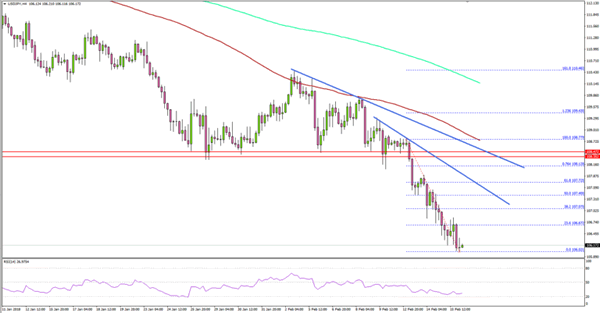Key Highlights
- The US Dollar declined heavily this week and moved below the 108.20 support against the Japanese Yen.
- There are two bearish trend lines forming with resistance at 107.40 and 108.10 on the 4-hours chart of USD/JPY.
- The US Initial Jobless Claims for the week ending Feb 10, 2018 rose from the last revised reading of 223K to 230K.
- The US Industrial Production in Jan 2018 declined 0.1% (MoM), whereas the market was looking for 0.2%.
USDJPY Technical Analysis
The US Dollar was under a lot of bearish pressure this week against the Japanese Yen. The USD/JPY pair broke a major support at 108.20 and moved into the bearish zone.

Looking at the 4-hours chart of USD/JPY, the pair clearly faced an increased selling pressure and declined by more than 200 pips. After the 108.20 support break, the pair traded below the 108.00 and 107.00 support levels.
The downside move was strong and the pair traded close to the 106.00 level. A low was formed at 106.02 from where a minor correction was initiated. On the upside, an initial resistance is around the 23.6% Fib retracement level of the last decline from the 108.77 high to 106.02 low.
There are also two bearish trend lines forming with resistance at 107.40 and 108.10 on the same chart. If the pair corrects substantially from the current levels, the broken supports at 107.50 and 108.00 are likely to act as resistances.
On the downside, a break below the recent low of 106.02 could push the pair below 105.80. The next major support is at 105.40, followed by 105.00.
UK Industrial Production
Recently in the US, the Industrial Production for Jan 2018 was released by the Board of Governors of the Federal Reserve. The market was looking for an increase of 0.2% in the Industrial Production compared with the previous month.
The actual result was well below the forecast, as there was a decline of 0.1% in the Industrial Production. This was also well below the last increase of 0.4%. The report added:
Manufacturing production was unchanged in January. Mining output fell 1.0 percent, with all of its major component industries recording declines, while the index for utilities moved up 0.6 percent. At 107.2 percent of its 2012 average, total industrial production was 3.7 percent higher in January than it was a year earlier.
Overall, the US Dollar remains in a bearish zone versus other major currencies such as the Euro, British Pound, Japanese Yen and Aussie Dollar. Today, the Building Permits and Housing Starts reports for Jan 2018 will be released, which may impact the greenback in the short term.












